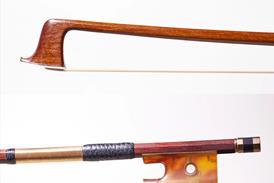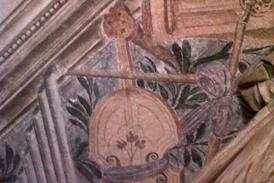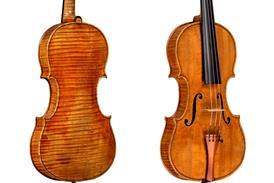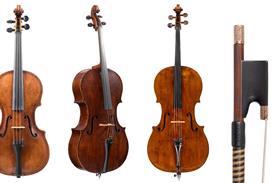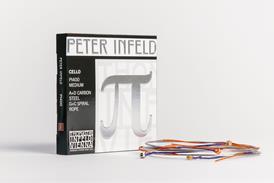All Lutherie articles – Page 40
-
 Article
ArticleGiuseppe Sgarbi - an overlooked individualist?
In an era when luthiers were not precious about putting elements of their own personality into the models to which they referred, the 19th century maker Giuseppe Sgarbi created instruments that have a unique vibrancy and individuality
-
 Article
Article‘When you are on a hill, the sound is good’
Luthier Stefan-Peter Greiner on the mysterious art of sound-adjustment
-
 Review
ReviewBook review: Eugène Sartory: Documents and photographs concerning his life and work, presented by his grandson Philippe Dupuy
Philip Brown reviews a book of memories on the great 20th-century bow maker
-
 Premium ❘ Feature
Premium ❘ FeatureStefan-Peter Greiner on individuality in violin making
For Stefan-Peter Greiner, instrument making is not about copying; it’s about individuality, experimentation and intuition. In conversation with Pauline Harding, the German luthier discusses his ideas on sound adjustment, ‘Stradivari frequencies’ and creating the ideal working environment
-
 Focus
FocusAre contemporary violin makers limiting their potential to develop new ideas?
A key aim of the VSA/Oberlin Workshop ‘Obie 1’ project was to create a good original violin design that was not directly derived or copied from a previous instrument
-
 Focus
Focus9 tips on working with violin bridges
Advice on how to fit, adjust and design your bridge from The Strad Archive
-
 Premium ❘ News
Premium ❘ NewsAuction Report: January 2020
Old Italians and a modern bow proved popular at this autumn’s auctions, as Kevin MacDonald reports
-
 Premium ❘ Feature
Premium ❘ FeatureBuying the right instrument for you
Whatever your needs, whatever your budget, there's an instrument out there for you. Laurinel Owen suggests some ways to find it
-
 Premium ❘ Feature
Premium ❘ FeatureTrade Secrets: a peninsular bench extension
Ideas for a workplace addition that is completely accessible from all three of its sides
-

-
 Premium ❘ Feature
Premium ❘ FeatureMaking Matters: the DNA of design
David Beard argues that the old Cremonese makers had a geometric system of design ‘recipes’ to create the vast number of different instrument patterns we see today
-
 Premium ❘ Feature
Premium ❘ FeatureSeeing red
Madder root has been used since ancient times to provide a deep red pigment – but the process of making it remains mysterious. For the past three years Hugh Withycombe and Guy Harrison have tested different methods to get the recipe just right – and can now reveal their findings
-
 Premium ❘ Feature
Premium ❘ FeatureOn the borders of greatness
Giuseppe Sgarbi’s instruments have a unique vibrancy and individuality, while still respecting the traditional Cremonese forms. Lorenzo Frignani examines his career, as well as that of his son Antonio, to suggest why his work deserves more recognition than it has in the past
-
 News
NewsNew film tells the story of the bowmaker’s art
The Bowmakers journeys from the workshops of Port Townsend to the Brazilian Amazon rainforest
-
 Video
VideoThe Bowmakers Trailer
‘The story of the most important instrument you’ve never heard of.’ A new feature film by documentary filmmaker Ward Serrill tells the story of the ‘silent servant’ of the music world: the bow. The Bowmakers takes viewers on a journey from the workshops of five master bowmakers in the Pacific ...
-
 News
NewsBowmaker Paul Martin Siefried has died
The eminent American bowmaker, master copyist and restorer has died, aged 69
-
 Premium ❘ Gallery
Premium ❘ GalleryFrom the Archive: a viola of the Gofriller School, Venice c.1700-10
An illustration of a viola of the Gofriller School published in The Strad, February 1962
-
 Blogs
BlogsHow a flight-damaged Edward Lewis viola da gamba rose from the ashes
After being seriously damaged in an Alitalia flight, a historical viola da gamba made by Edward Lewis was amazingly brought back to life by Shlomo Moyal. Here is the story of the instrument, to tie in with this month’s Making Matters
-
Video
My Space: Stephen Quinney
The Toronto luthier gives a demonstration of his craft in a 2017 episode of the series History in the Making
-
 Premium ❘ Feature
Premium ❘ FeatureMaking Matters: a phoenix from the ashes
Luthier Shlomo Moyal explains how he restored a 1685 viola da gamba that had been almost destroyed, in a project that took a whole year of patient reconstruction





